Research outline
Research overview
March 2025 showed tentative signs of recovery for the global cryptocurrency market following February’s turmoil. While volatility persisted—especially early in the month—market sentiment gradually improved amid easing macro pressures and renewed institutional interest.
Bitcoin stabilized after a steep February drop, even briefly reclaiming mid-$88K levels, as Ethereum attempted to find a floor despite lingering headwinds. Altcoins saw a mixed but generally positive turn: Several large-cap tokens rebounded modestly, and select mid-caps rallied on project-specific news. However, caution prevailed, with traders remaining mindful of February’s lessons.
The month was defined by:
- Macroeconomic relief and policy clarity: The U.S. Federal Reserve held rates steady and hinted at future easing despite inflation concerns, while President Trump softened his aggressive tariff stance—alleviating some risk-off sentiment. Regulatory clarity improved as the SEC signaled a more constructive approach by dropping its appeal in the Ripple case.
- Institutional moves bolstering confidence: A $584 million Bitcoin purchase by MicroStrategy and modest inflows returning to Bitcoin ETFs underpinned market optimism. At the same time, major exchanges and funds pursued growth (e.g., Coinbase’s talks to acquire Deribit), indicating continued long-term interest.
- Crypto sectors diverging: Real-world asset (RWA) tokenization and DeFi platforms quietly expanded, with total RWA value locked surpassing $10B. AI-related tokens and memecoins led short-term rallies as risk appetite ticked up toward month-end. In contrast, NFT markets remained in a downturn, with trading volumes hitting multi-month lows despite growth in user participation.
- Security and trust rebuilding: Following February’s record hacks, March saw no breaches on the same scale, but security remained a focal point. A $8.4M exploit of an RWA protocol and other minor incidents kept developers and exchanges vigilant, implementing safeguards and collaborating with law enforcement to prevent another Bybit-scale event.
Thematic market shifts
- Cautious optimism returns: After extreme fear in early March, sentiment improved to a neutral/fearful stance by month-end (Crypto Fear & Greed Index rising from sub-20 lows to the 40s), as investors tentatively re-entered markets on signs that February’s sell-off had bottomed.
- Leadership of Bitcoin over altcoins: Bitcoin’s dominance rose as it weathered March’s turbulence better than most altcoins, hovering near 60% of total market cap by late month. Investors favored the relative safety of BTC amidst uncertainty, though a late-month altcoin uptick hinted at restoring risk appetite.
- Rotation into quality and innovation: Capital showed signs of rotating into sectors with strong narratives or fundamental usage. DeFi platforms offering real-world yields, AI-oriented projects, and certain Layer-1 ecosystems with upcoming upgrades attracted disproportionate interest—whereas purely speculative rallies were shorter-lived.
- Market stabilization amid lower volumes: Overall trading volumes remained below January highs, reflecting a more measured market. Volatility subsided compared to February’s extremes, partly due to fewer liquidations and a consolidation of positions. Still, liquidity remained thinner than in late 2024, making the market prone to sharp moves on news events.
Looking ahead
As the market moves into April 2025, participants are watching whether the late-March momentum can sustain into a broader recovery. Key factors include Bitcoin’s ability to firmly break above the psychological $90K–$100K zone, Ethereum’s Pectra upgrade in Q2 (and its impact on network usage), and any regulatory milestones (such as potential U.S. ETF approvals or new legislation). The industry’s response to security challenges will also be crucial in restoring trust. March laid cautious groundwork through consolidation and resilience—April will test whether this sets the stage for broader recovery or renewed volatility.
Key takeaways
Here’s a concise breakdown of March 2025’s most notable trends and developments across the crypto ecosystem:
Bitcoin rebounds as institutions re-enter cautiously
- BTC recovered from a March low of ~$75K, briefly spiking to $88.7K before closing the month just under $87K.
- MicroStrategy’s $584M Bitcoin buy bolstered confidence, helping offset earlier ETF outflows.
- U.S. spot Bitcoin ETFs saw inflows return by late March, reversing February’s negative trend.
- Bitcoin dominance held steady despite rising memecoin interest.
Ethereum lags behind amid weak sentiment, but fundamentals stay strong
- ETH traded below $2,200 for most of March and closed the month near $2,050, hitting lows near $1,750 before recovering slightly.
- ETF outflows persisted early in the month, though signs of stabilization emerged by month-end.
- Ethereum staking reached a new high (31M+ ETH locked), and active validators exceeded 920K.
- The upcoming Pectra upgrade in Q2 became a focal point for long-term investor optimism.
Altcoins diverge: XRP, SOL, and FIL shine while others stall
- Solana (+15%) led large-cap rebounds, bouncing from ~$110 to ~$127.
- XRP gained ~10% after the SEC dropped its appeal, solidifying Ripple’s legal win.
- Filecoin surged +18% on upgrade excitement and ecosystem growth.
- Mid-tier altcoins without strong narratives remained mostly flat or rangebound.
Top crypto sectors of March: DeFi-RWA, AI tokens, and memecoins
- RWA protocols crossed $10B in total value locked (TVL), led by MakerDAO and BlackRock’s BUIDL fund.
- AI tokens (e.g., AGIX, FET) rallied on renewed hype and integration news.
- Memecoins saw late-month spikes—DOGE rose 7.8% after an Elon Musk tweet, SHIB and PEPE followed with double-digit jumps.
NFT market contracts, but participation ticks up
- NFT sales volume dipped to ~$418M in March, down ~12% month-over-month.
- Blue-chip collections like BAYC and CryptoPunks saw further floor price declines.
- However, active NFT traders and transactions rose, hinting at steady user engagement despite lower prices.
- Polygon and Mythos chains gained ground amid continued brand and gaming NFT activity.
Security focus intensifies post-February chaos
- No billion-dollar hacks in March, but the $8.4M Zoth RWA exploit reminded users that vulnerabilities persist.
- A GitHub supply chain attack targeting Coinbase’s repositories triggered software pipeline reviews across exchanges.
- Platforms implemented new safeguards: MPC wallets, admin time-locks, and phishing detection tools gained traction.
Bitcoin’s March 2025 recap: Rebounding amid cautious optimism
Bitcoin navigated a path of gradual recovery in March 2025 following a steep decline in February, reflecting resilience amid lingering macroeconomic uncertainties.
Key points
- BTC started the month around $85,000–$86,000, experiencing a sharp “V-shaped” recovery after dipping to lows of $74,500–$76,000.
- Bitcoin ended March with a marginal monthly loss (~3%), significantly better than its February decline (~17%).
Price volatility and key levels
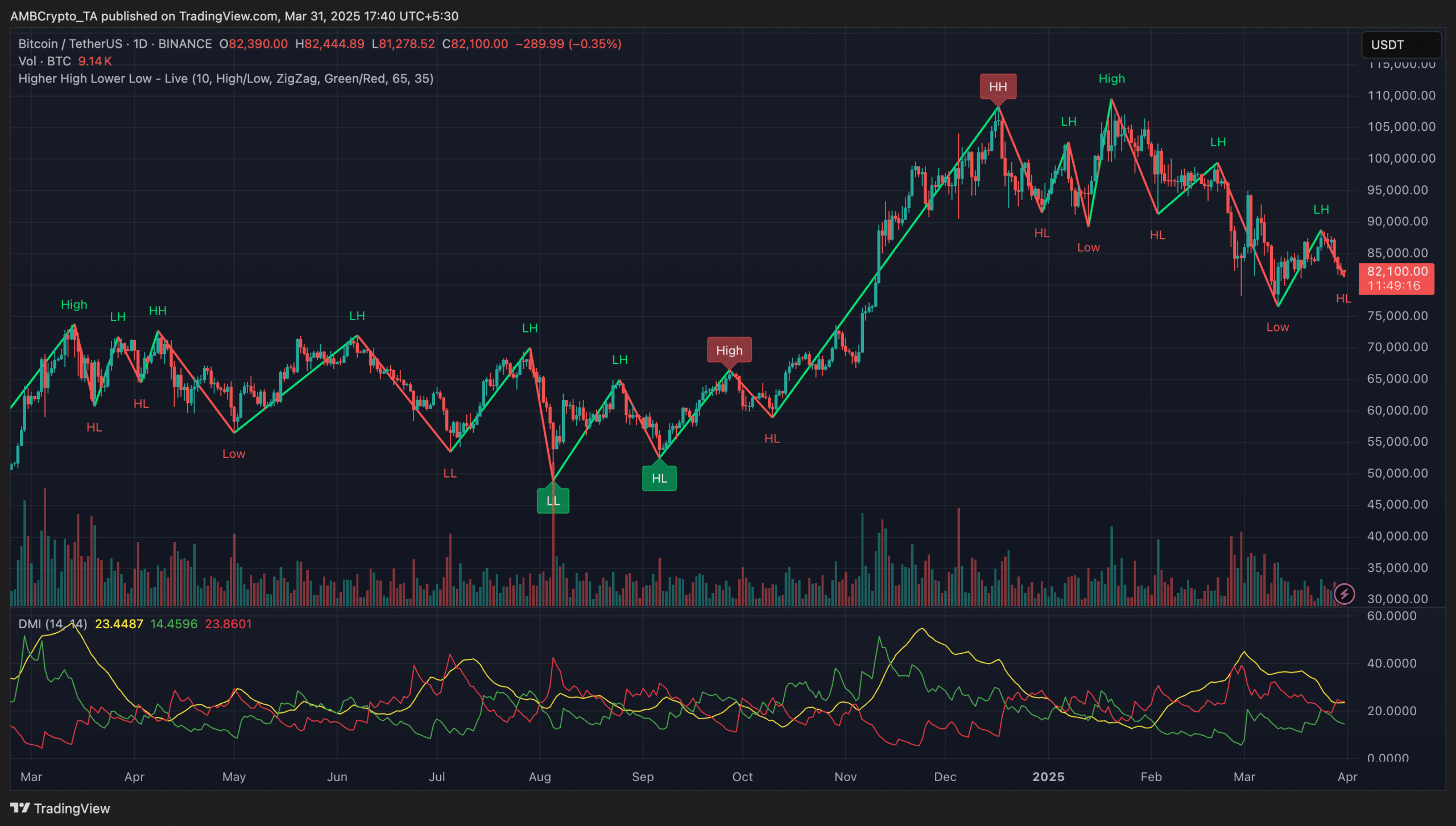
BTC’s price movement | Source: TradingView
- Bitcoin opened March trading near $85,000–$86,000, still reeling from February’s steep correction.
- Early-month fears pushed BTC briefly down into the $74,500–$76,000 zone by the second week, influenced by investor caution and macroeconomic pressures.
- By March 25, Bitcoin rebounded sharply to approximately $87,000, briefly peaking at $88,758 before retracing slightly, highlighting improved market sentiment yet persisting resistance.
Drivers of the recovery
Two significant factors catalyzed Bitcoin’s mid-month turnaround:
Easing macroeconomic concerns
- Investor confidence improved significantly following reports that President Trump’s proposed April tariffs would be narrower and more flexible than initially anticipated.
- The U.S. Federal Reserve indicated potential rate cuts later in 2025, further boosting market optimism.
- Analysts commented, “Bitcoin is attempting to form a bottom, supported by Trump’s recent flexibility on tariffs.”
Institutional accumulation
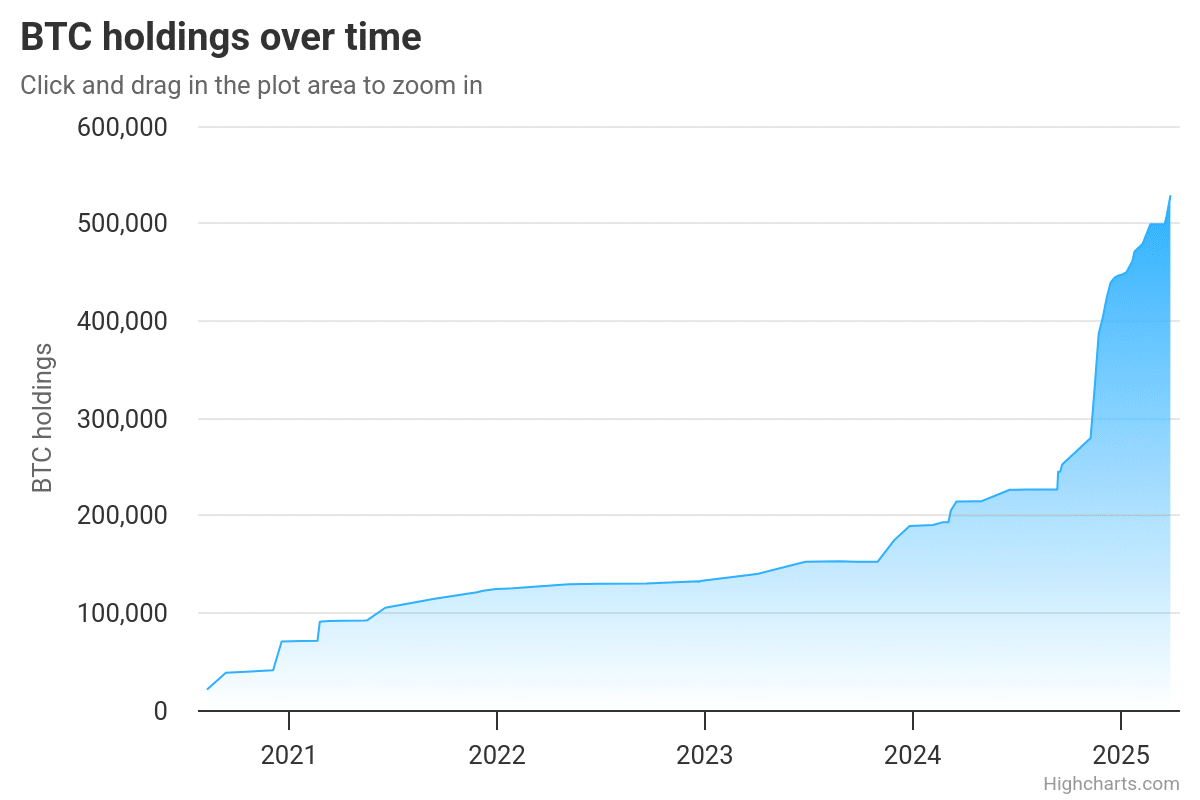

MicroStrategy’s BTC holdings over time | Source: BiTBO
- MicroStrategy executed a substantial $584 million Bitcoin purchase, one of its largest acquisitions to date, signaling robust institutional confidence.
- Following this announcement, Bitcoin rapidly climbed toward $88,000, reflecting immediate positive market response.
- Additionally, U.S. spot Bitcoin ETFs experienced renewed inflows after weeks of net withdrawals, hinting at cautious but tangible institutional re-entry.
On-chain and market trends
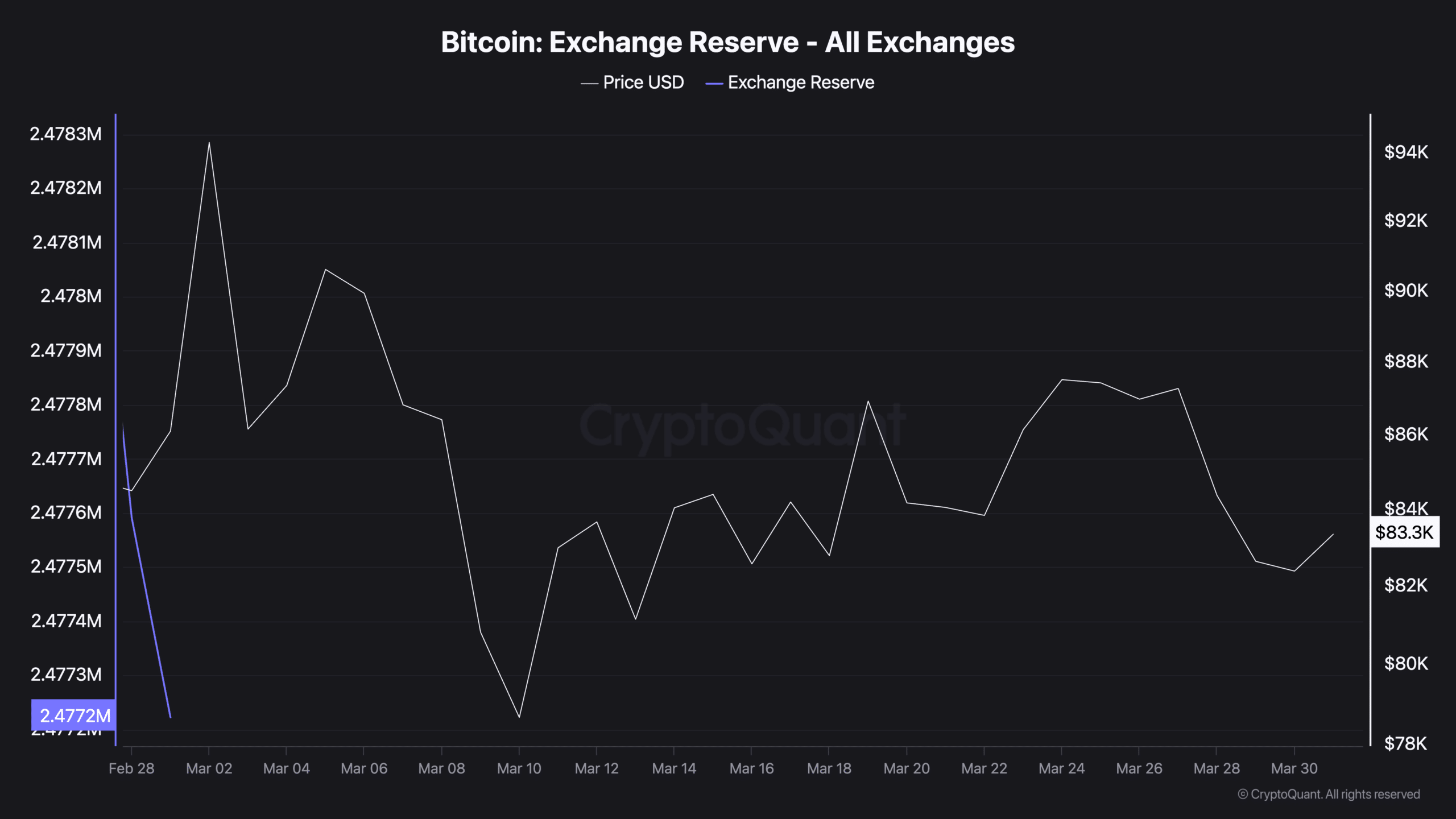

Bitcoin Exchange Reserve – All Exchanges | Source: CryptoQuant
- Exchange reserves continued to decline slightly in early March as investors moved Bitcoin to cold storage, signaling steady long-term holder accumulation amid market dips and post-Bybit hack concerns. Although not at multi-year lows, reserves remained suppressed throughout the month, reflecting a broader trend of cautious investor behavior.
- On-chain activity remained relatively stable month-over-month, with no dramatic surge or decline in active addresses or transaction volumes, indicating cautious yet consistent market participation.
- Futures funding rates turned positive by late March, and open interest gradually increased, suggesting traders’ cautious positioning for further upside.
Market sentiment and dominance
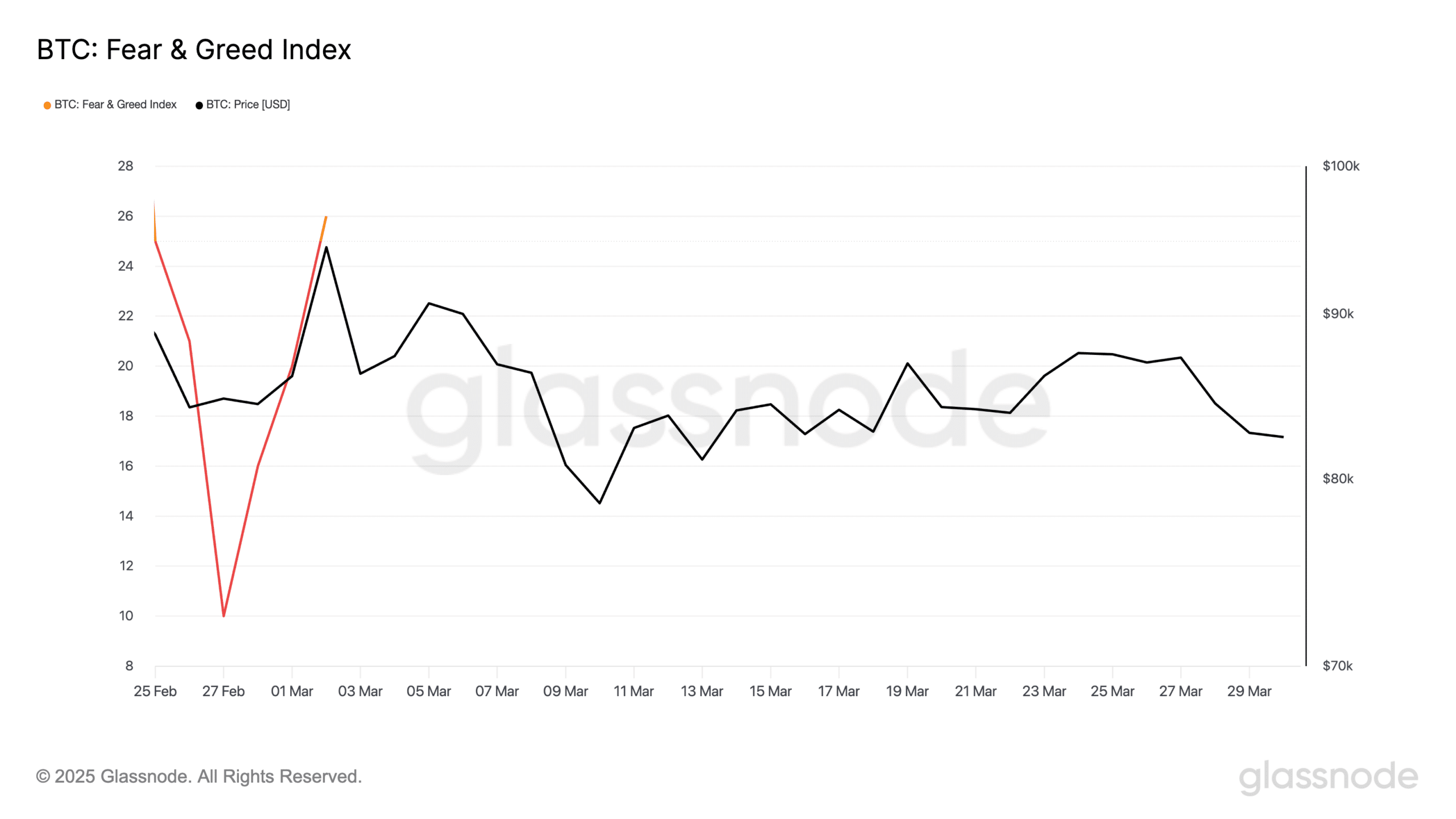

BTC: Fear & Greed Index | Source: Glassnode
- Bitcoin’s market sentiment showed minor improvement in early March, with the Crypto Fear & Greed Index recovering from “Extreme Fear” levels (~10 on Feb 28) to the low-20s by the first week. However, sentiment remained subdued throughout the month, oscillating between 16 and 23, indicating persistent caution among market participants.
- Bitcoin’s market dominance increased slightly, surpassing 59–60% by late March (up from ~58% in February), as investors cautiously rotated funds from altcoins into BTC amid lingering uncertainty.
- Market analysts noted, “Market sentiment remains cautiously optimistic, with altcoin gains present but Bitcoin still commanding investor focus due to institutional support and ETF inflows.”
What’s next?
Bitcoin demonstrated clear resilience in March, successfully defending the critical support around the $80,000 level and regaining confidence following macroeconomic clarity and renewed institutional interest. However, the inability to decisively breach the $90,000 barrier signals remaining caution among investors.
Moving into Q2 2025, Bitcoin’s ability to build on March’s cautious optimism will largely depend on external economic developments, institutional flows, regulatory updates, and ongoing network strength. Investors will closely monitor whether current momentum translates into sustained upward trends or if volatility continues to cap BTC’s upside.
Investor sentiment exclusive: 5.3K+ weigh in on government-held Bitcoin reserves
In recent months, several governments have begun holding Bitcoin as a reserve asset, a move that has sparked significant debate within the cryptocurrency community. Does government involvement enhance Bitcoin’s credibility, or does it fundamentally undermine crypto’s core principles of decentralization and financial freedom? AMBCrypto’s latest exclusive survey, drawing responses from over 5,300 investors, sheds light on this contentious topic.
Could government-controlled Bitcoin reserves lead to market manipulation?
A notable concern among investors is the potential for market manipulation if governments maintain substantial Bitcoin reserves.
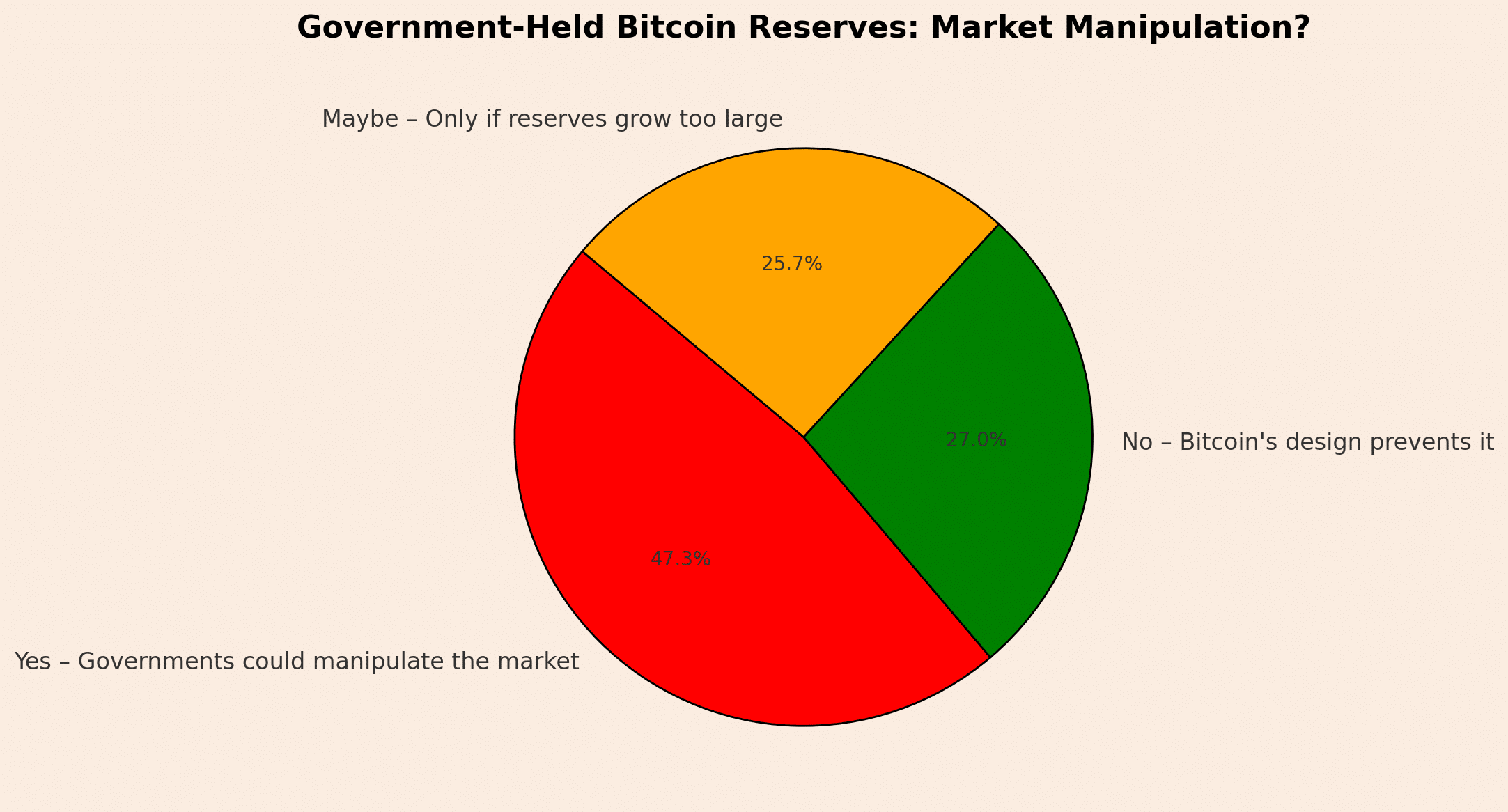

Likelihood of market manipulation by government-held Bitcoin reserves
The survey revealed that nearly half (47.3%) of respondents perceive a genuine risk, believing that governments could influence Bitcoin’s supply and market price. In contrast, 27.0% remain confident in Bitcoin’s decentralized design, arguing it inherently safeguards against manipulation. Another 25.7% think manipulation might occur, but only if reserves grow excessively large, suggesting a cautious optimism tempered by vigilance.
This split underscores ongoing worries about government influence conflicting with Bitcoin’s decentralized ethos, emphasizing the delicate balance the crypto community seeks between adoption and autonomy.
Government Bitcoin reserves: A boost or threat to fiat currency?
Investors also weighed in on whether governments holding Bitcoin reserves would strengthen or weaken traditional fiat currencies.
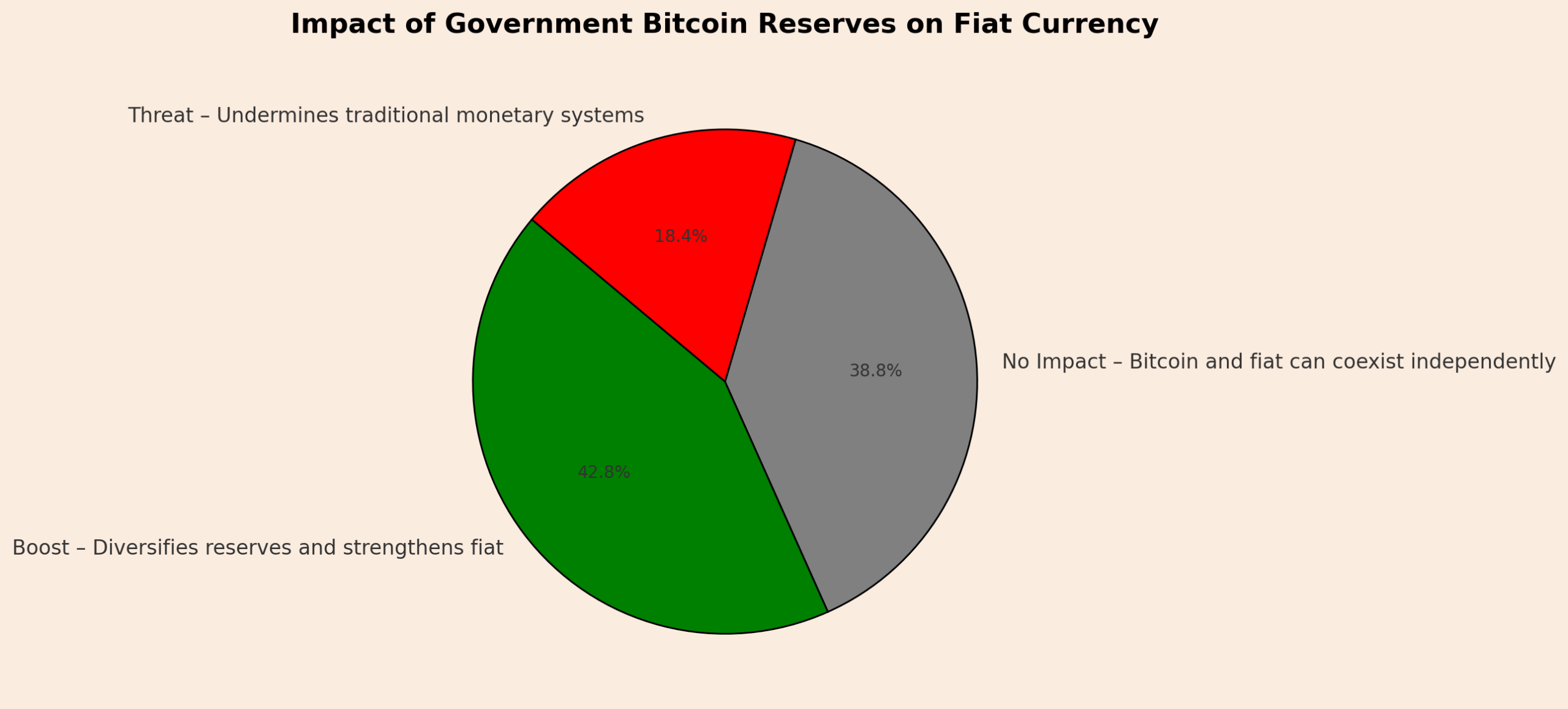

Impact of government Bitcoin reserves on fiat currency
A plurality (42.8%) believes incorporating Bitcoin diversifies national reserves, thus bolstering fiat currencies. Conversely, 18.4% fear this strategy undermines traditional monetary systems, potentially weakening fiat. Meanwhile, 38.8% see no direct impact, arguing that Bitcoin and fiat can coexist independently without significant effects on each other.
These findings reflect broader uncertainty about Bitcoin’s role in global finance, as investors grapple with its potential as both a stabilizing and disruptive financial force.
Investors’ biggest concerns and hopes regarding government Bitcoin holdings
The survey’s open-ended question about investors’ key hopes and concerns yielded particularly insightful responses. Predominantly, participants expressed anxiety over governments potentially undermining Bitcoin’s decentralization, exerting excessive control, or manipulating markets. However, there was also considerable optimism: many respondents hope government involvement might increase institutional legitimacy, accelerate mainstream adoption, and spur further financial innovation.
One investor summarized this dual sentiment succinctly: “Government involvement could finally give Bitcoin mainstream credibility, but it must be carefully managed to avoid sacrificing the decentralization that makes Bitcoin valuable.”
Navigating adoption with caution
Overall, AMBCrypto’s March 2025 survey reveals a crypto community cautiously receptive to governments holding Bitcoin, provided such holdings remain transparent and limited enough to preserve Bitcoin’s core principles. Investors are optimistic about increased legitimacy and mainstream adoption, yet remain wary of potential centralization risks and market manipulation.
Ultimately, while government-controlled Bitcoin reserves could represent a significant step toward broader acceptance, ensuring this adoption aligns with Bitcoin’s foundational values remains the community’s key priority moving forward.
Macroeconomic and regulatory trends: March’s market shapers
Global economic and regulatory events significantly influenced cryptocurrency markets in March 2025, notably in the U.S., where policy decisions and economic shifts provided both relief and caution.
Key points
- The Federal Reserve’s steady rate stance and easing trade tensions positively influenced market sentiment.
- Significant regulatory developments, particularly in the Ripple case, bolstered crypto legitimacy.
- Institutional engagement and market infrastructure developments continued robustly despite market volatility.
Federal Reserve policy and inflation
- The U.S. Federal Reserve maintained steady interest rates in mid-March and indicated potential rate cuts later in 2025.
- The U.S. core inflation remained just above 3% year-over-year, slightly above target, while headline inflation hovered around 2.8%—reinforcing the Fed’s patient stance.
- Crypto markets, sensitive to interest rate dynamics, reacted positively, stabilizing alongside equities.
Trump’s tariff and trade policy developments
- Initial market fears from President Trump’s proposed reciprocal tariffs (25% on Canada & Mexico) significantly eased as March progressed.
- Reports of more flexible and narrower tariff implementations emerged, alleviating investor concerns.
- Bitcoin and major equity indices responded positively, notably rallying on the announcement of potential tariff exemptions.
Regulatory developments and clarity
Ripple case resolution:
- The SEC officially dropped its appeal against Ripple Labs, providing critical regulatory clarity around XRP, affirming it as a non-security in secondary markets.
- The ruling significantly enhanced investor confidence and broadened altcoin legitimacy.
Crypto Task Force & legislative progress:
- SEC Commissioner Hester Peirce’s Crypto Task Force engaged industry stakeholders to develop clearer regulatory frameworks.
- A comprehensive bipartisan crypto regulatory bill re-emerged, aimed at clarifying SEC and CFTC jurisdictions and setting stablecoin issuance standards.
ETF developments:
- March saw renewed net inflows into the U.S. Bitcoin ETFs, reversing February’s trend.
- Market optimism rose regarding potential approval of Ethereum spot ETFs, driven by a notably softer regulatory stance.
- Trump Media & Technology Group partnered with Crypto.com, announcing plans for crypto-themed ETF products.
Global regulatory landscape
- EU: Conducted compliance workshops preparing for MiCA (Markets in Crypto-Assets) regulations scheduled later in 2025.
- Asia: Hong Kong’s retail crypto market attracted steady capital inflows, solidifying its position as a crypto hub.
- UAE: Updated guidelines for crypto businesses operating within its jurisdiction.
Institutional and market infrastructure developments
Mergers & acquisitions:
- Coinbase engaged in discussions to acquire Deribit, potentially marking a major consolidation in the crypto derivatives market.
Investment fund initiatives:
- DWF Labs launched a new $250 million fund targeting mid- to large-cap crypto projects, reflecting strategic market positioning.
- Wall Street firms increased crypto holdings, taking advantage of the market dip to strategically enhance exposure.
Exchange expansion and regulation:
- Nasdaq began onboarding institutional clients for crypto custody services, setting the stage for broader crypto trading offerings.
- Kraken obtained an EU e-money license to expand crypto-fiat services under the upcoming MiCA regulations.
- Binance adjusted its offerings in specific jurisdictions to align better with regulatory frameworks.
Institutional adoption:
- Fidelity reported significant growth in 401(k) accounts allocating assets to Bitcoin, showcasing increasing mainstream acceptance.
- A notable U.S. university endowment fund publicly disclosed investment in a crypto-focused venture capital fund, indicating growing institutional comfort.
What’s next?
The macroeconomic and regulatory environment in March provided essential support for market recovery, reducing near-term risks and improving investor sentiment. Moving forward, sustained market resilience and growth will likely depend on continued regulatory clarity, macroeconomic stability, and ongoing institutional participation.
Ethereum in March: Awaiting catalysts amid subdued recovery
Ethereum’s recovery in March 2025 was relatively muted, lagging behind Bitcoin as it struggled to regain upward momentum due to ongoing investor caution and lack of immediate bullish triggers.
Key points
- Ethereum largely traded below $2,000, reaching a monthly low around $1,750–$1,780, before partially recovering to around $1,950–$1,980 by late March.
- Institutional ETF outflows persisted but stabilized by the end of the month, hinting at a possible turnaround.
Price volatility and market movement
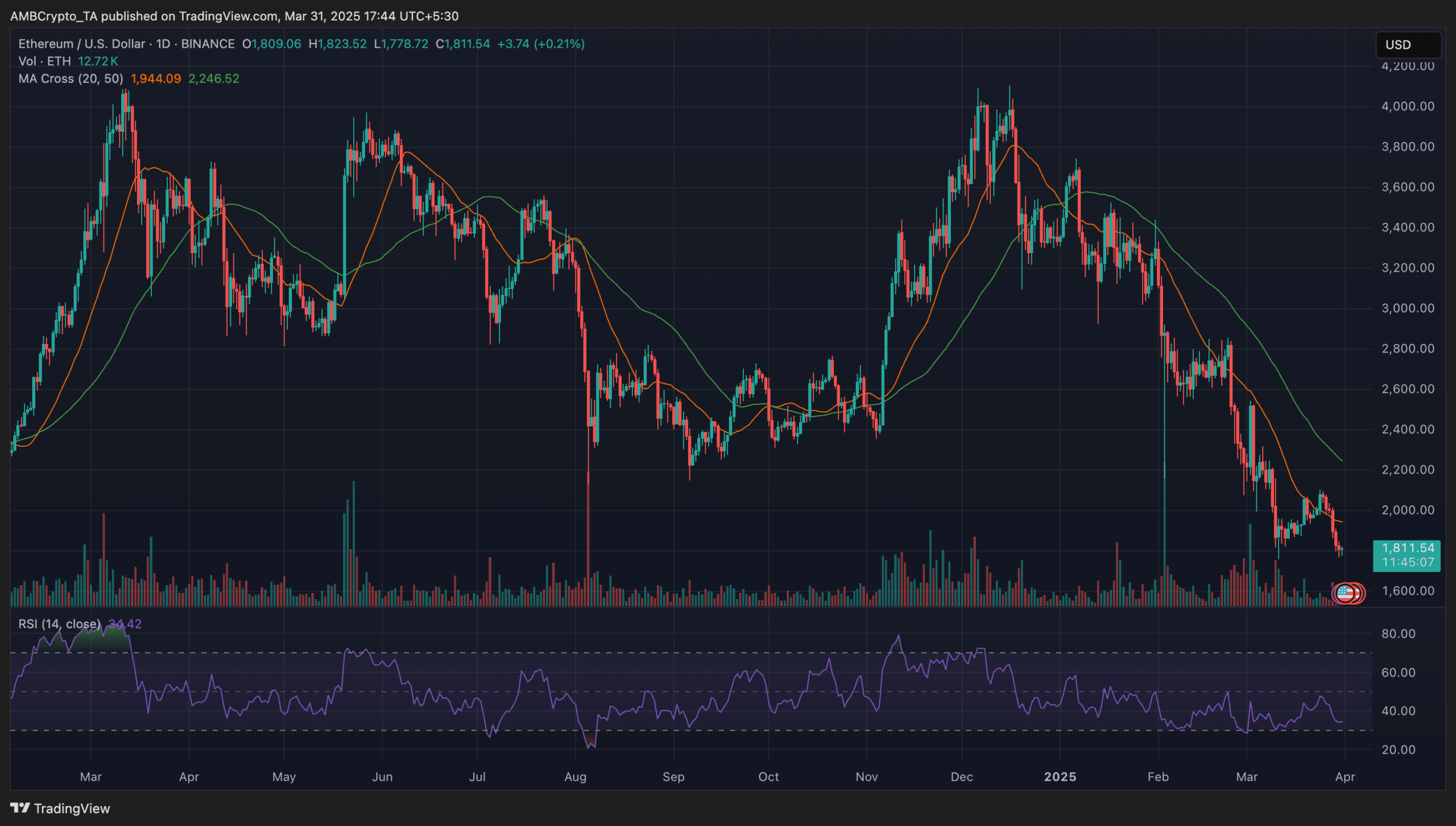

ETH’s price movement | Source: TradingView
- Ethereum opened March near $1,950–$2,000 following continued late-February selling pressure and quickly declined further below the psychologically significant $2,000 mark amid persistent market uncertainties.
- The asset recorded its lowest monthly price around $1,750–$1,780, marking the lowest levels since mid-2024.
- Despite a modest recovery, ETH ended approximately 7–9% lower month-on-month, significantly underperforming Bitcoin.
Institutional trends and ETF activity


Spot Ethereum ETF AUM (Daily) | Source: The Block
- Institutional interest in Ethereum-focused products remained cautious, with spot ETF assets under management (AUM) continuing their February downtrend during early March. Although outflows persisted, the pace slowed mid-month, and AUM levels showed signs of stabilization in the final week.
- While early March experienced significant daily outflows (reportedly over 16,000 ETH), the latter half saw smaller inflows, suggesting tentative institutional re-entry amid improving sentiment.
- Ethereum’s ETF AUM hovered between $6.5 billion and $7.3 billion throughout March, showing no major recovery but also avoiding further steep declines.
Network fundamentals and staking
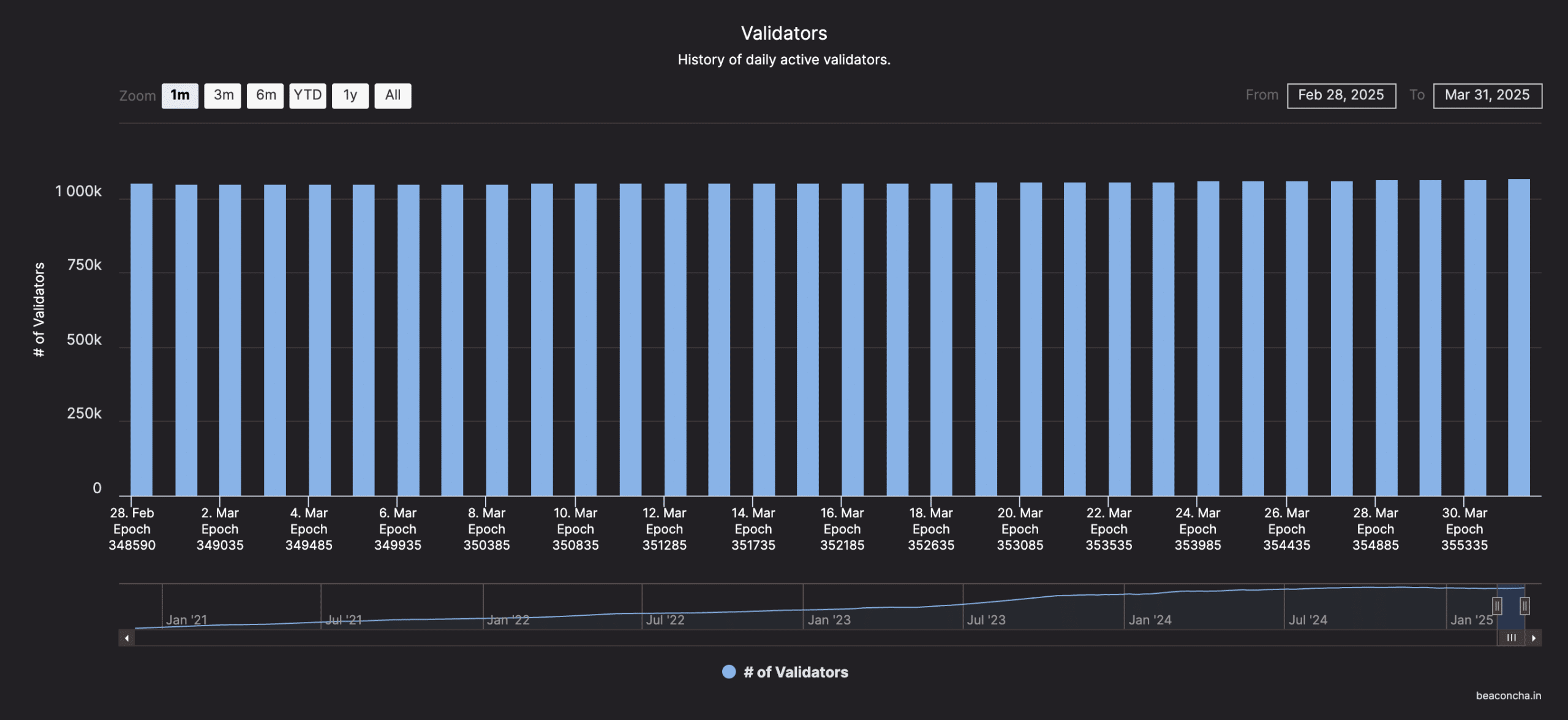

ETH Validators | Source: beaconcha.in
- Ethereum’s fundamental metrics demonstrated strength despite price weaknesses, with the number of active validators rising above 920,000, up from approximately 900,000 in February.
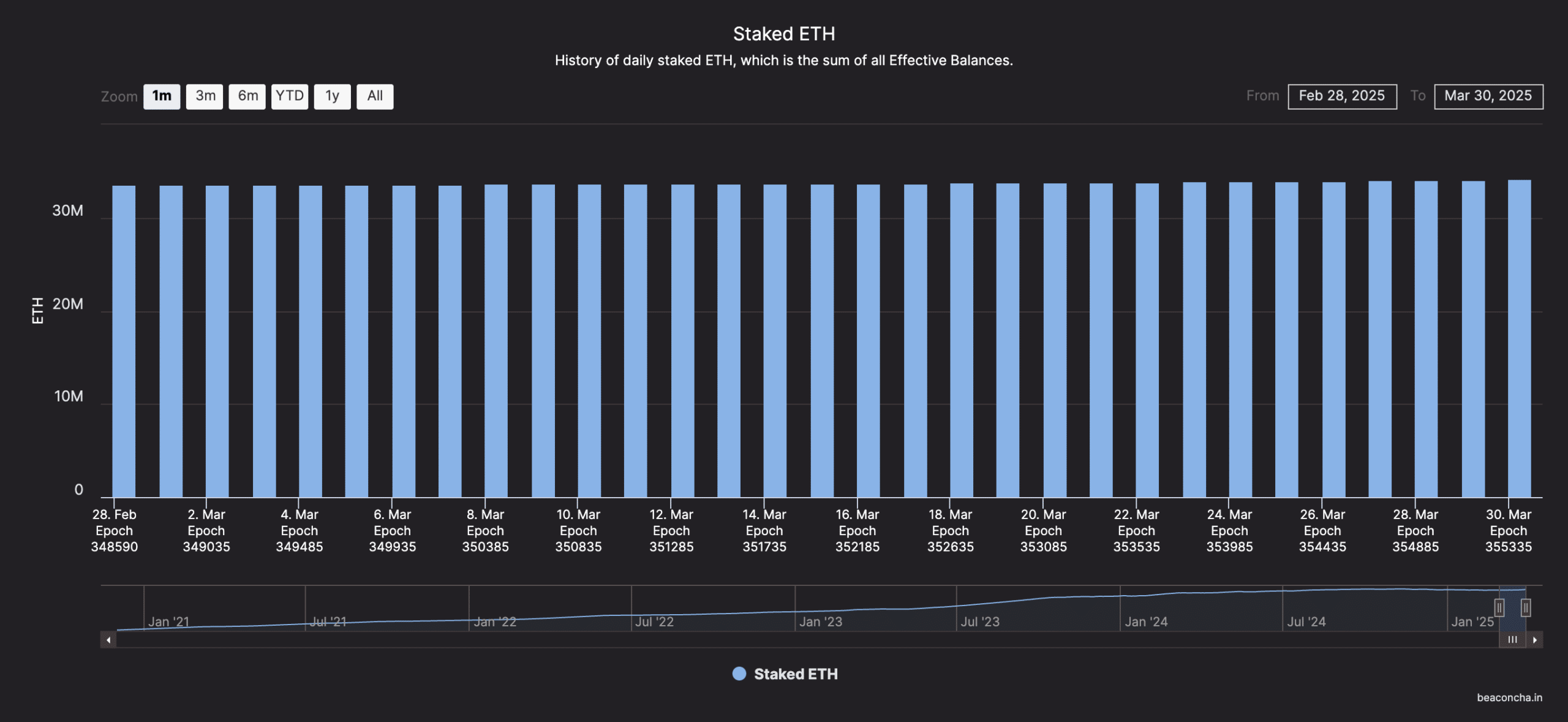

Staked ETH | Source: beaconcha.in
- Total ETH staked reached an all-time high, surpassing 31 million ETH, emphasizing sustained long-term investor confidence and the attractiveness of staking rewards.
- Ether’s available supply on exchanges fell to its lowest point since November 2015, indicating increased movement to staking or long-term storage.
- Daily transactions and DeFi activity saw slight increases in late March, primarily driven by memecoin trading and Layer-2 scaling solutions, although NFT trading activity continued its downward trajectory.
Derivatives and market sentiment
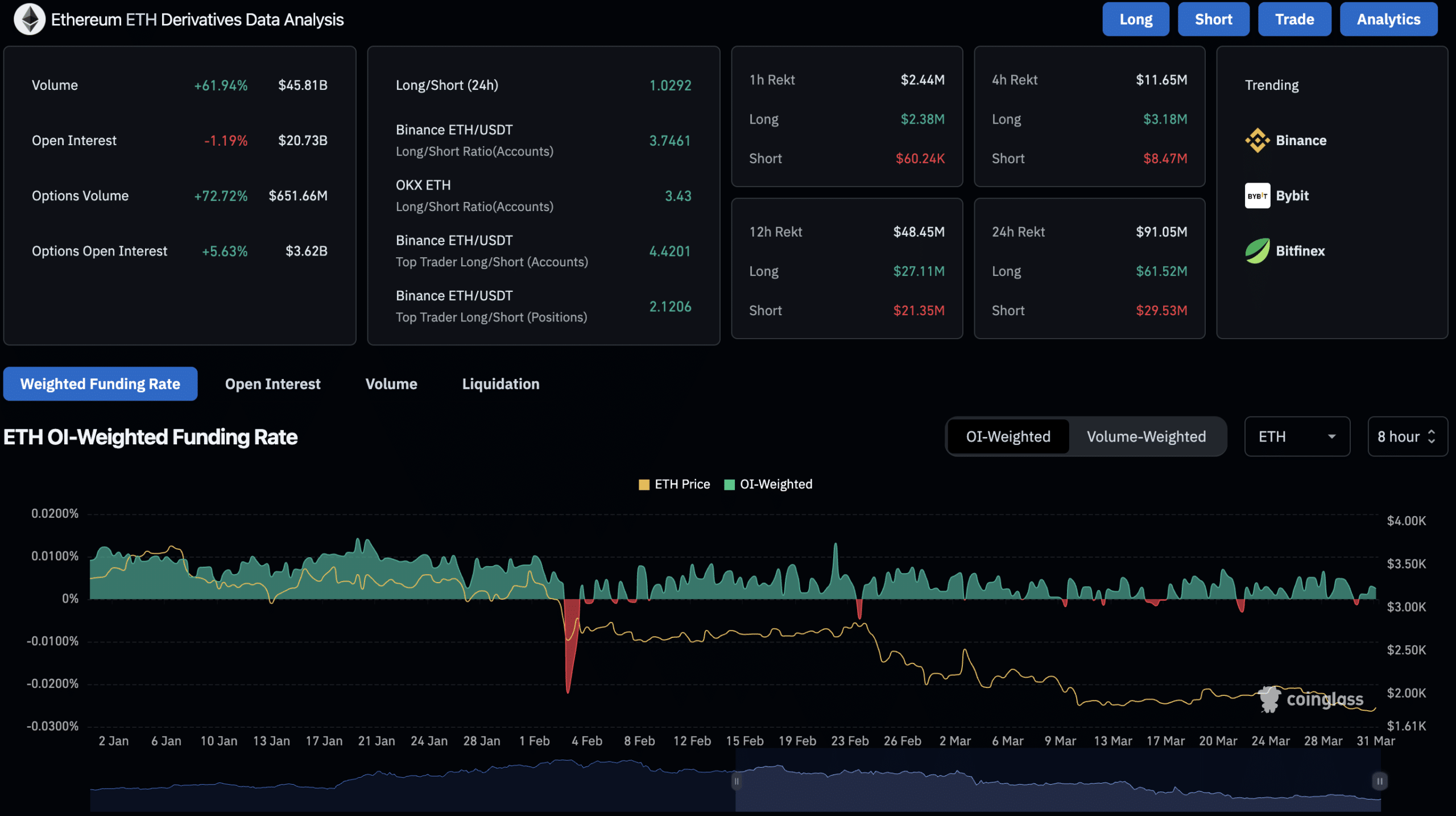

Ethereum ETH Derivatives Data | Source: CoinGlass
- Ethereum’s derivatives market echoed cautious investor sentiment, with open interest remaining subdued and futures funding rates hovering near neutral before turning slightly positive by the month’s end.
- The ETH options market reflected moderation, with traders positioning for relatively lower volatility compared to February’s extremes.
- Despite price pressure, long/short ratios and volume metrics across top exchanges indicated stable engagement in Ethereum’s derivatives market.
Upcoming catalysts: Pectra upgrade
- The Ethereum community closely watched developments related to the upcoming “Pectra” upgrade, scheduled for Q2 2025, aimed at significantly enhancing network efficiency and throughput.
- Successful testnet deployments in March set a positive technical groundwork, although immediate market reactions were subdued.
- Market analysts highlighted potential bullish momentum if the Pectra upgrade achieves expected performance improvements, creating a speculative “buy the rumor” atmosphere reflected in slightly rising ETH open interest toward month-end.
What’s next?
Ethereum concluded March in a cautious stance, underperforming Bitcoin and remaining about 7–9% lower than its February close. While persistent concerns around institutional ETF outflows and lack of immediate bullish catalysts weighed on price action, robust underlying network metrics and anticipation of the Pectra upgrade offer potential optimism.
As the market moves forward, Ethereum’s trajectory will likely depend significantly on broader macroeconomic stability and the successful implementation of upcoming upgrades. Investors remain watchful, positioning Ethereum for a potential recovery should positive catalysts materialize.
Altcoin market overview: Mixed March with selective gains
March 2025 was marked by an initial extension of February’s bearish sentiment in the altcoin market, which later gave way to selective recoveries among tokens backed by strong fundamentals or significant news.
Key points
- Early March saw extended losses across major altcoins, with significant rebounds emerging by mid-to-late month.
- Altcoins ended March with modest overall gains, although recovery was notably uneven.
General market performance
- Large-cap altcoins (excluding Ethereum) faced early-month pressure, declining an additional 5–15% from February’s already significant losses.
- Solana (SOL) fell from approximately $140 at February’s close to around $105–$110 by March 10, recovering partially to about $123–$125 by month-end.
- Cardano (ADA) and XRP also experienced similar downward trajectories initially. XRP dipped to about $1.95–$2.00 before bouncing strongly mid-month to around $2.60–$2.70, though it retraced to close March near $2.07.
- Dogecoin (DOGE) saw a late-month recovery, rising roughly 8% during the final week amidst renewed memecoin interest.
- The total altcoin market capitalization bottomed mid-month and closed March near $0.50 trillion, marking a modest net gain.
Rotation into quality altcoins
Investors became more selective, favoring altcoins with clear, positive developments:
Protocol upgrades and launches:
- Filecoin (FIL) surged approximately 9–14%, driven by anticipation for its CalibrationNet upgrade and heightened network activity.
- Polygon (MATIC) gained approximately 10% due to upcoming hardfork announcements aimed at network scalability.
- Animecoin (ANIME) also rallied ahead of its mainnet launch, capturing market attention.
Ecosystem strength and strategic partnerships:
- Ripple (XRP) strengthened significantly mid-month after the SEC withdrew its appeal, providing regulatory clarity and triggering renewed institutional interest.
- Chainlink (LINK) rose approximately 12%, boosted by new real-world asset partnerships and increased adoption of its Cross-Chain Interoperability Protocol (CCIP).
Technical oversold bounces:
- Solana (SOL) and Dogecoin (DOGE) benefited notably from technical rebounds after substantial February declines, positioning them as top performers late in the month.
March 2025’s top altcoin performers
Solana (SOL)
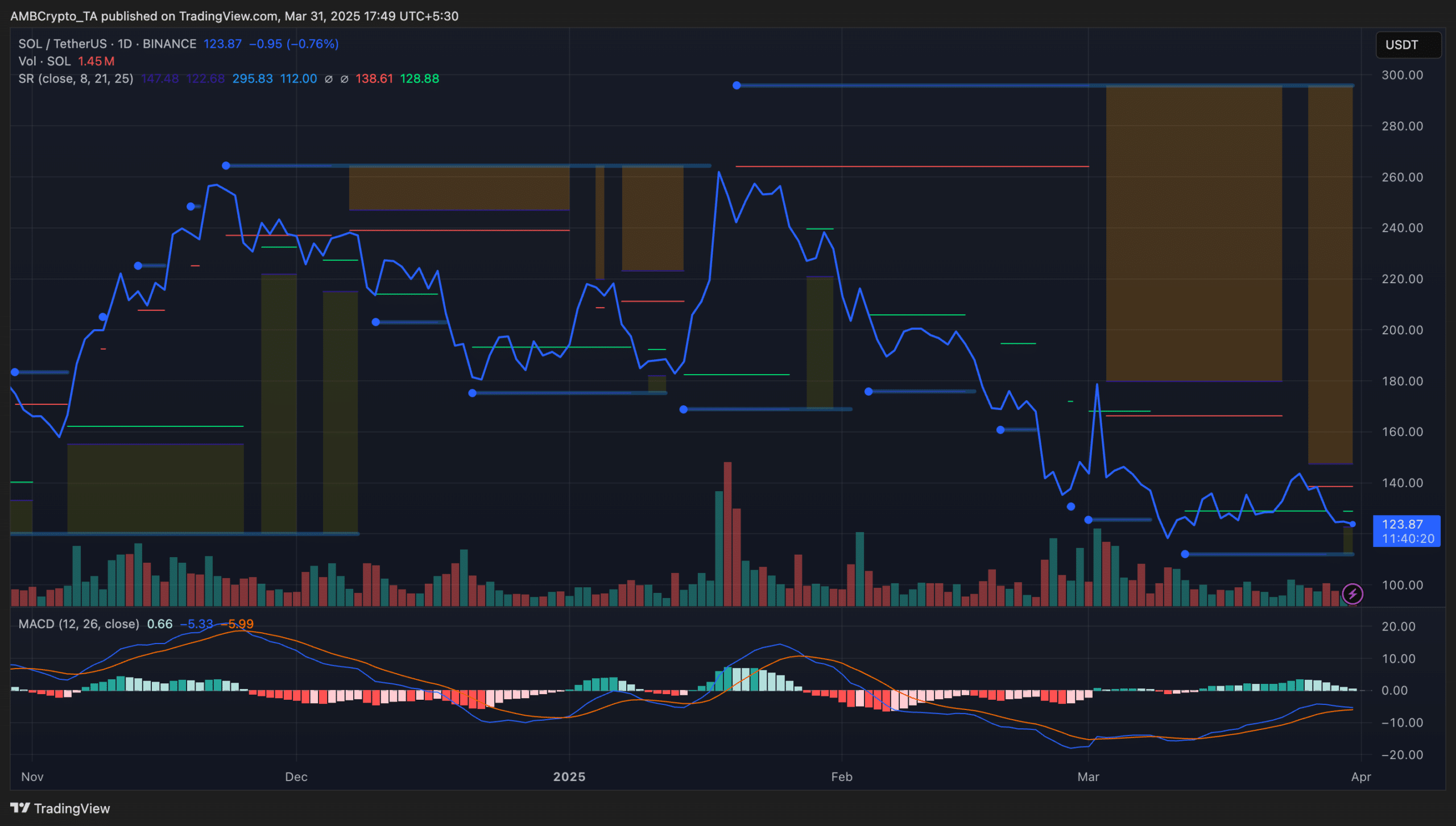

SOL’s price movement | Source: TradingView
- Performance: ~+15–18% from monthly lows.
- Catalysts: Network stability reassured investors, while new GameFi launches and a developer conference bolstered sentiment.
- Context: SOL held critical support around $100, signaling a potential bottom and attracting renewed buyer interest.
Ripple (XRP)
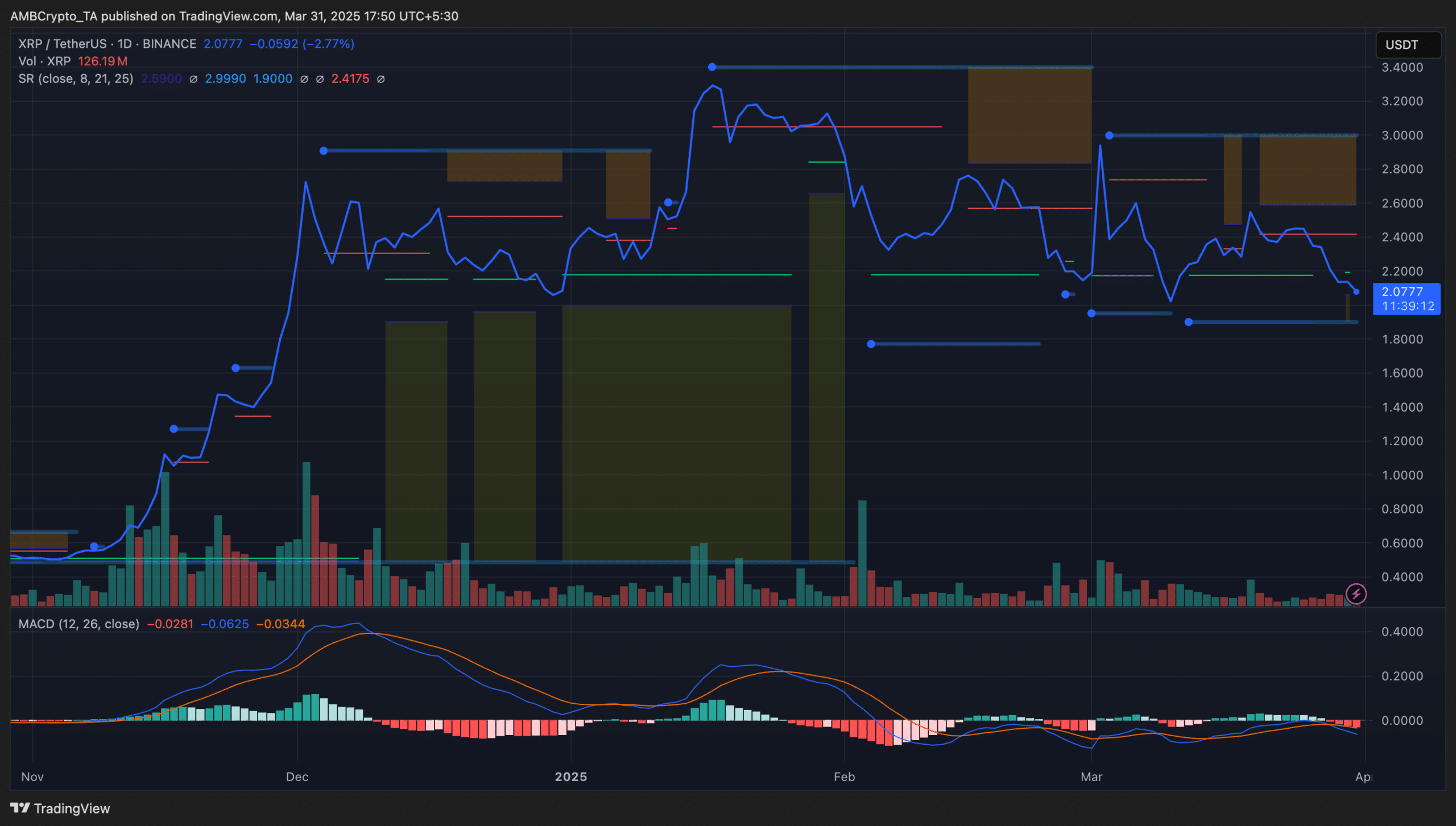

XRP’s price movement | Source: TradingView
- Performance: Mid-month recovery peak of ~30–35%, with net monthly close ~5% higher than monthly lows.
- Catalysts: SEC’s decision to drop its appeal provided significant regulatory relief. Ripple also expanded Asian banking partnerships, enhancing real-world usage potential.
- Highlight: XRP distinguished itself through fundamental developments rather than speculative trading, boosting investor confidence.
Filecoin (FIL)
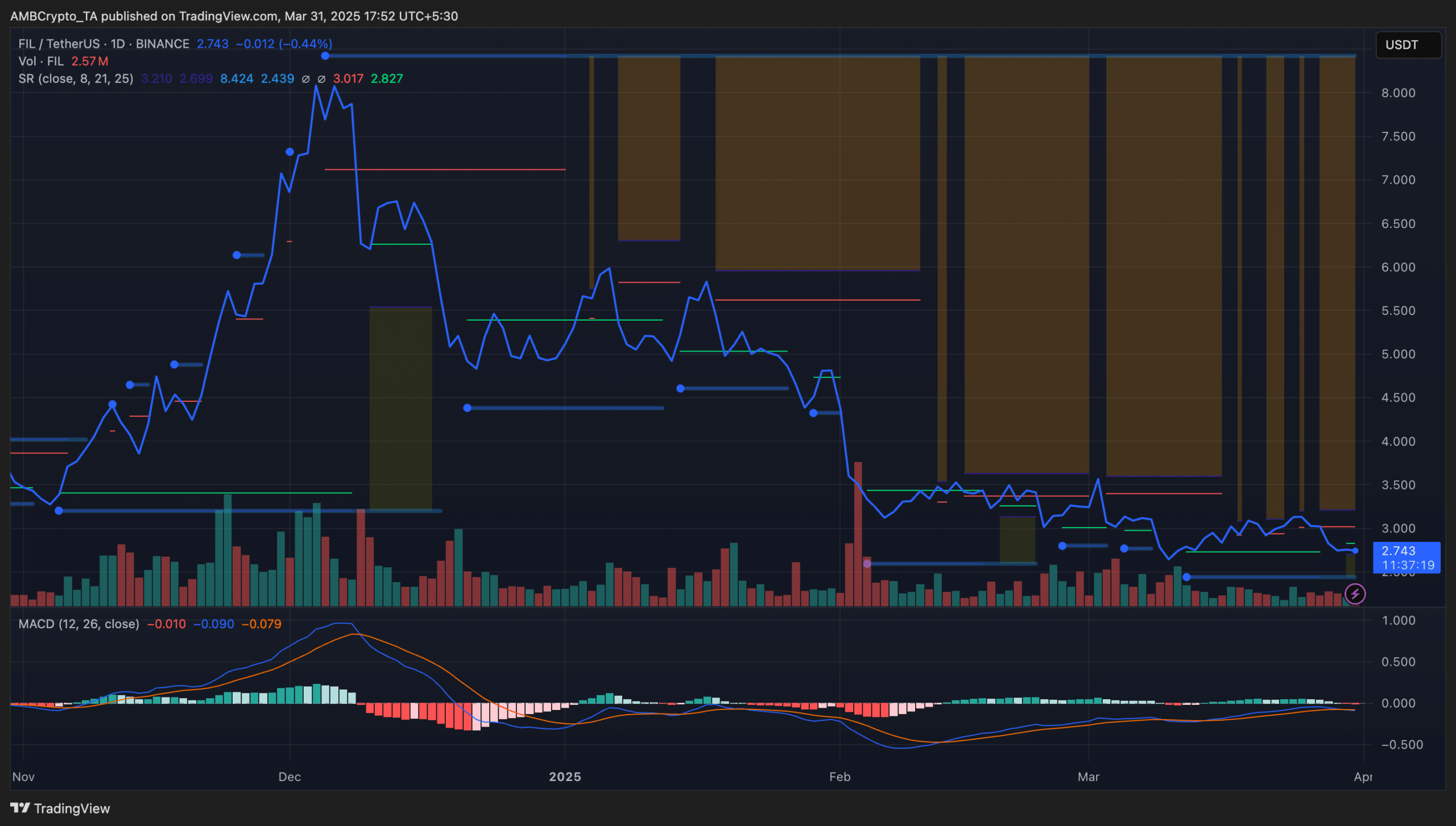

FIL’s price movement | Source: TradingView
- Performance: ~9–14%.
- Catalysts: CalibrationNet upgrade promising improved storage efficiency sparked investor enthusiasm. The Filecoin ecosystem saw growth in both storage capacity and network participation.
- Notable strength: FIL’s March performance underscored the benefit of tangible milestones, allowing it to outperform despite broader market trends.
Honorable mentions
- Dogecoin (DOGE): Late-month spike (~+10%) due to speculation around Twitter integration.
- Maker (MKR): Strength derived from sustained DeFi activity and real-world asset collateral growth.
- Kaspa (KAS): Significant increase driven by testnet upgrade hype.
Top crypto sectors: March 2025 standouts
Amid the crypto market’s mixed performance in March 2025, three distinct sectors notably outperformed, driven by specific narratives, strong adoption, and investor enthusiasm.
Key points
- Decentralized Finance (DeFi) & Real-World Asset (RWA) tokenization emerged resilient amid market volatility.
- AI-related cryptocurrencies maintained strong momentum, boosted by continuous innovation and mainstream attention.
- Memecoins and social tokens experienced a notable late-month revival, driven by speculative investor interest.
Decentralized finance (DeFi) & real-world assets (RWAs)
Resilient performance:
- DeFi platforms integrating real-world assets experienced robust demand despite broader market weaknesses.
- Total value locked (TVL) in RWA protocols surpassed $10 billion by late March, highlighting increased adoption in tokenized treasuries, real estate, and other traditional assets.
Key developments:
- MakerDAO saw significant growth in TVL and revenue due to RWA collateral utilization for its DAI stablecoin.
- BlackRock’s BUIDL and Ethena’s USDtb each exceeded $1 billion in TVL, underscoring market confidence.
Investor interest:
- The appeal of yield-bearing assets in a low-rate environment attracted institutional investments, including a notable $250 million allocation to established DeFi protocols.
AI-related cryptocurrencies
Continuous momentum:
- AI-focused crypto projects maintained strong investor attention, driven by ongoing technological breakthroughs and mainstream integration announcements.
Standout performers:
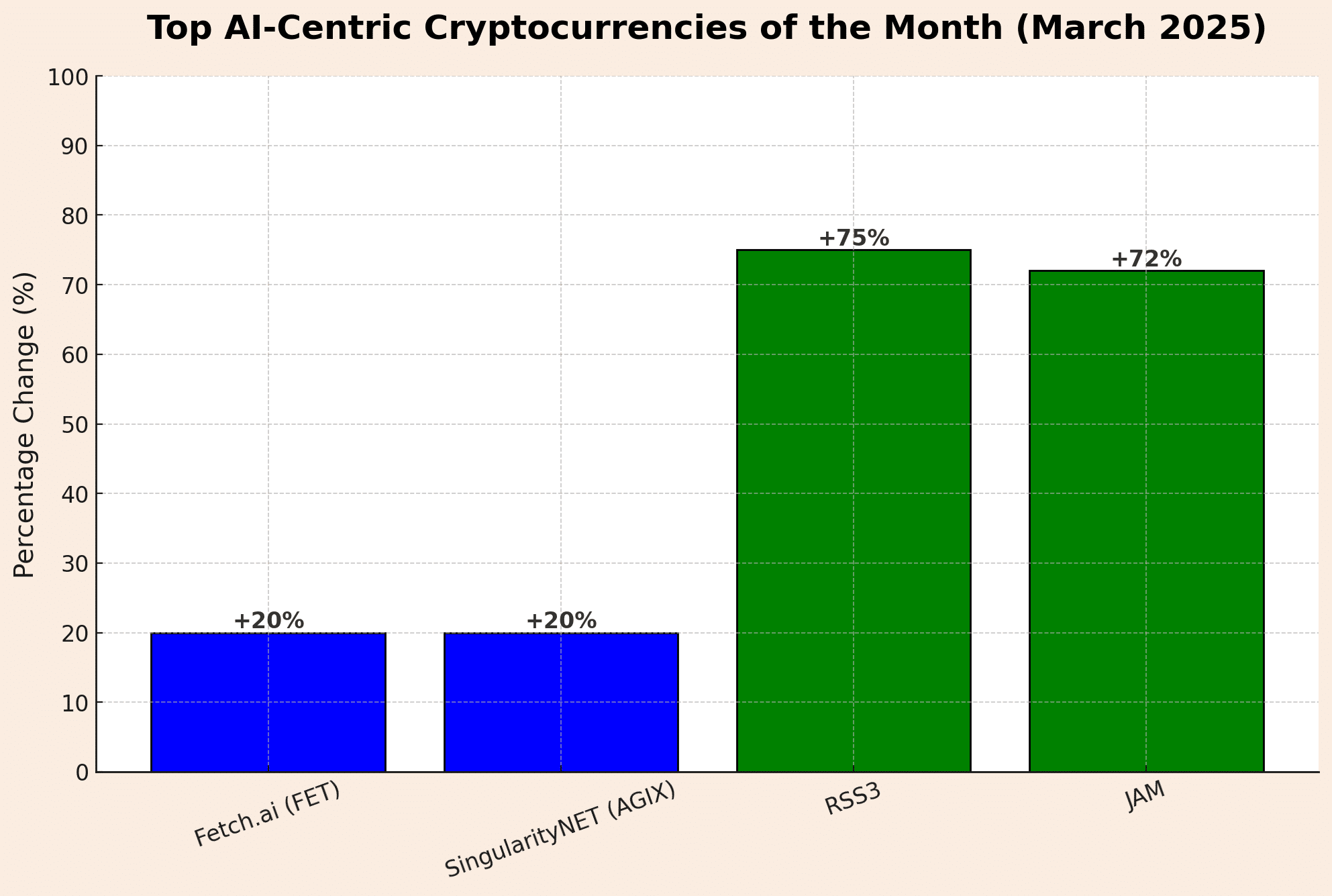

Top AI tokens in March 2025
- Fetch.ai (FET) and SingularityNET (AGIX) experienced ~20% surges in trading volumes within short mid-month spans.
- Smaller AI tokens such as RSS3 and JAM significantly outperformed the market, with monthly gains exceeding 70%.
Narrative strength:
- Sustained interest was fueled by influential market voices, notably Crypto Rover’s “ALTSEASON 2025 IS COMING” tweet, explicitly highlighting AI cryptos.
- Overall, the AI crypto sector index rose approximately 8% in March, distinctly outperforming the broader flat market.
Memecoins & social tokens
Late-month revival:
- The memecoin sector rebounded significantly toward March’s end after early-month declines following February’s downturn.
Key highlights:
- Dogecoin (DOGE) surged 7.8% on March 25, influenced by speculative anticipation around Elon Musk’s potential Twitter integrations.
- Shiba Inu (SHIB), Pepe (PEPE), and other community-driven tokens recorded substantial gains, demonstrating increased retail interest.
Investor activity:
- Active addresses interacting with meme tokens spiked in late March, driving decentralized exchange volumes higher.
- The satirical token “TRUMP” briefly surged 9% following humorous endorsements by President Trump, underscoring the speculative nature and retail-driven enthusiasm in this segment.
What’s next?
These top-performing sectors—DeFi & RWAs, AI cryptos, and meme tokens—indicate selective investor optimism and risk appetite returning to niche areas. Continued growth or sustained performance in these sectors will depend heavily on macroeconomic conditions, further technological advancements, and market sentiment stability in the coming months.
NFT market wrap: Weak volumes, stronger engagement
The NFT market in March 2025 continued to experience volume declines, reflecting ongoing correction pressures from previous peaks. However, underlying user engagement remained resilient, bolstered by robust participation and selective market strength.
Key points
- NFT trading volumes declined further, continuing the downtrend from late 2024.
- Despite falling volumes, user engagement notably increased, signaling sustained interest.
- Alternative blockchains and innovative NFT collections showed relative strength.
Trading volume and pricing trends


NFT Global Sales Volume | Source: CryptoSlam
- Monthly NFT trading volume reached approximately $418 million, marking a roughly 12% decline from February ($476 million).
- Weekly volumes hit a significant low near $84 million during March 17–23, the weakest weekly performance since November 2024.
- Notable NFT collections experienced pricing pressure, with CryptoPunks maintaining high-value sales, topping at ~$2.19 million (CryptoPunk #4464), but overall collection valuations softened.
User participation and market engagement
- Unique buyers increased to around 570,000, up from approximately 551,000 in February, signaling rising user engagement.
- NFT transaction counts were approximately 5.21 million for the month, showcasing significant activity despite lower average sale prices ($78).
- Wash trading volumes significantly reduced by 83%, enhancing market transparency and reliability.
Blockchain-specific developments
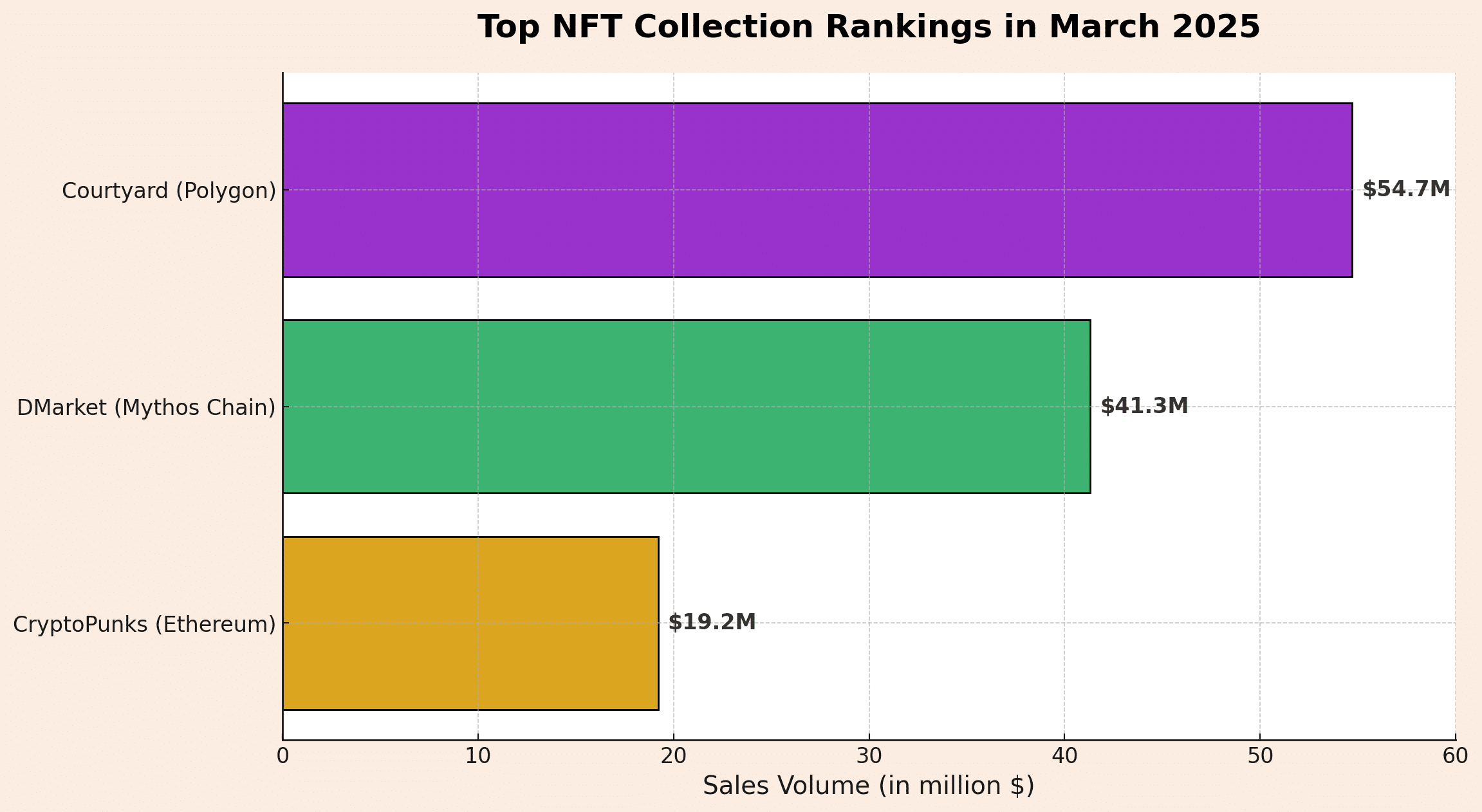

Top NFT Collections in March 2025
- Polygon’s Courtyard collection ranked first by volume ($54.7 million), driven by mass-market appeal and major partnerships.
- Mythos Chain’s DMarket ranked second, achieving $41.3 million, supported primarily by gaming NFTs.
- Ethereum-based CryptoPunks secured third place, generating approximately $19.2 million in sales, demonstrating continued premium demand despite market contraction.
- Bitcoin-based NFTs (BRC-20) maintained momentum, generating around $17.8 million, reflecting ongoing niche interest.
- Solana saw significant gains with “Paradise” NFTs surging to $15.8 million, showcasing a remarkable 491% monthly growth.
Notable NFT collections and events
High-profile sales
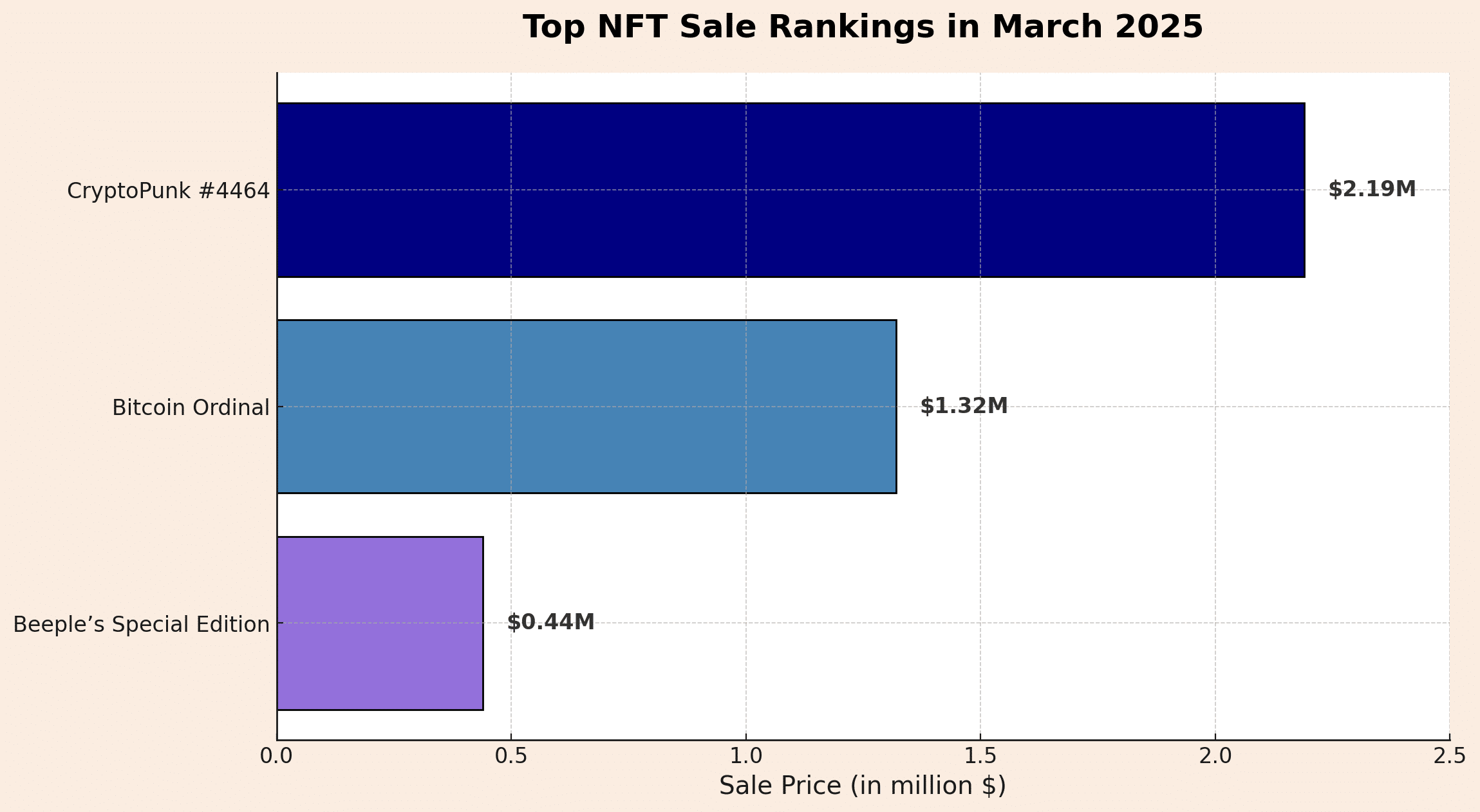

Top NFT Sales in March 2025
- CryptoPunk #4464 led the month with a sale of approximately $2.19 million (1,011 ETH).
- A notable Bitcoin Ordinal sold for about $1.32 million (14 BTC).
- Beeple’s special edition artworks each fetched over $440,000, underscoring continued collector interest.
Marketplace dynamics
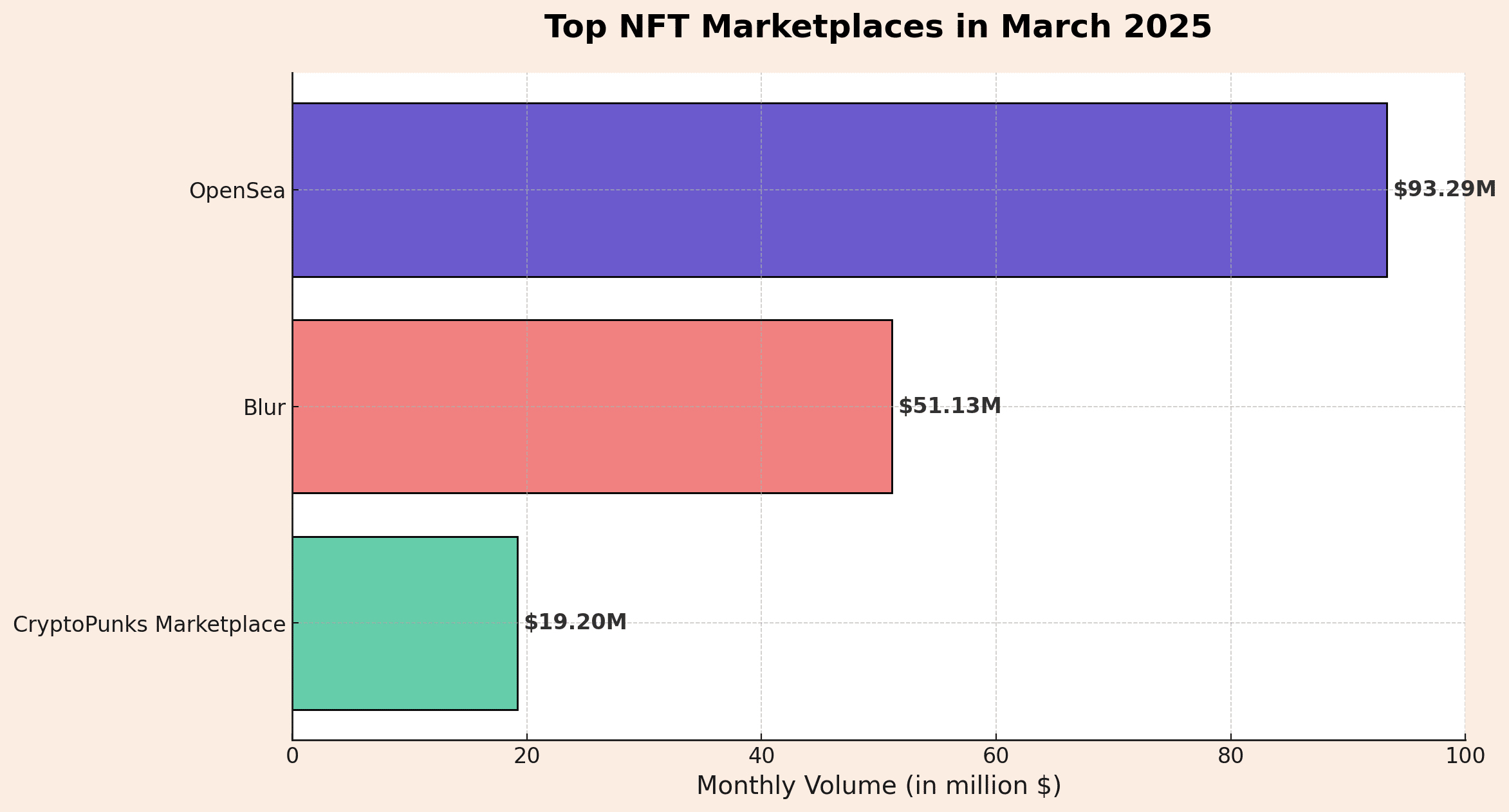

Top NFT Marketplaces in March 2025
- OpenSea remained the top marketplace with $93.29 million monthly volume, despite a substantial 58.8% volume drop.
- Blur maintained second place at $51.13 million, also down approximately 60.6%.
- CryptoPunks marketplace uniquely saw volume growth (up 8.85%) to $19.2 million, reflecting ongoing demand for premium collectibles.
Key metrics for March 2025
- Total NFT sales volume: $418 million (down from $476 million in February).
- Total NFTs sold: Approximately 5.21 million transactions.
- Active traders: Roughly 570,000 unique buyers for the month.
- Top-performing collection: Courtyard (Polygon), achieving $54.7 million in sales.
- Highest individual NFT sale: CryptoPunk #4464, selling for approximately $2.19 million.
What’s next?
Despite March’s declining volumes, increased user participation and notable performances in specific collections and alternative blockchains indicate potential market stabilization and selective resilience. Continued innovation, user growth, and strategic launches may support an NFT market recovery in subsequent months.
Security & trust: How the industry responded post-February’s wake-up call
Following February’s high-profile crypto hacks, security remained a significant focus in March 2025. While incidents were fewer and smaller, the industry responded decisively, enhancing security practices and restoring trust.
Key points
- No mega-hacks occurred in March, but DeFi protocols continued to face targeted exploits.
- Centralized exchanges and DeFi projects significantly ramped up security measures in response to ongoing threats.
- Industry-wide cooperation and rapid response initiatives emerged as strong themes, improving security infrastructure and user protections.
Notable security incidents
Zoth Protocol exploit:
- DeFi RWA re-staking protocol, Zoth, lost approximately $8.4 million due to compromised admin keys on March 21.
- Funds swiftly converted to DAI stablecoin and moved off-platform, highlighting vulnerabilities even in newer crypto sectors.
- Zoth temporarily halted operations, initiated a comprehensive investigation, and promised a transparent post-mortem and user compensation.
GitHub supply chain attack (CVE-2025-30066):
- Attackers targeted Coinbase’s open-source GitHub repositories, exposing CI/CD pipeline secrets.
- Coinbase promptly mitigated the issue, rotating keys before any crypto theft occurred.
- Incident underscored the rising threat of supply chain vulnerabilities, prompting industry-wide software security reassessments.
Industry security enhancements
Exchange initiatives:
- Exchanges implemented stricter withdrawal procedures, additional identity verification, and provided free hardware security keys to encourage secure user practices.
- Bybit led the creation of a shared blacklist among major exchanges to prevent cash-out attempts from known hacker addresses.
- Increased adoption of Multi-Party Computation (MPC) wallets to minimize single-point-of-failure risks.
DeFi security measures:
- New fail-safe measures such as admin function time-locks were introduced, allowing community intervention before suspicious large-scale withdrawals or code changes.
- Rising demand for rapid, comprehensive smart contract audits.
- Expansion of real-time contract monitoring tools that identify and alert communities to anomalous behaviors instantly.
User protection and education:
- Wallet providers like MetaMask enhanced phishing detection systems and launched updated user education campaigns.
- Ledger initiated campaigns incentivizing hardware wallet adoption through discounts, particularly targeting high-value wallet users.
- Some platforms floated or explored early prototypes of an ‘Undo’ feature for flagged transactions, though full implementations remained limited due to decentralization concerns.
Response to February’s major hacks
- Tens of millions in stolen funds were reportedly frozen or recovered, with law enforcement and exchanges coordinating globally—though full recovery remained elusive.
- Investigations identified North Korean-linked groups as primary suspects behind major hacks, prompting tighter monitoring of common laundering pathways.
- The Infini Protocol rug pull incident led to increased awareness around insider threats, prompting industry-wide dialogues on improved internal controls and audits.
- Regulatory bodies like the U.S. SEC and CFTC leveraged February incidents to advocate for stronger custodial regulations and clearer disclosures.
Outlook and future trends
March 2025 marked a critical turning point in crypto security, driven by enhanced vigilance and proactive community responses. With ongoing collaboration across the industry and authorities, the likelihood of preventing or quickly mitigating future breaches continues to improve. Such measures will remain essential for building sustained trust and fostering broader crypto adoption throughout 2025.
References
- BiTBO
- CryptoQuant
- Glassnode
- CoinGlass
- TradingView
- beaconcha.in
- DeFiLlama
- CryptoSlam
- DappRadar
- The Block
- Santiment
- IntoTheBlock
- Farside Investors
- CoinGecko
- CoinMarketCap
- Messari
- ETF.com
- Dune Analytics
- NFTGo
Disclaimer: This report analyzes data till March 25, 2025. It aims to provide comprehensive insights into market developments. All data presented is intended for informational and educational purposes. It’s crucial to note that no investment decisions should be made solely based on the information contained within this report. Ultimately, individuals are responsible for their own investment decisions and should conduct thorough research and analysis before making any financial commitments.







